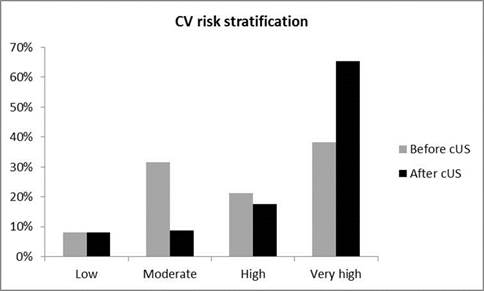Session Information
Session Type: ACR Poster Session A
Session Time: 9:00AM-11:00AM
Gout patients present carotid plaques at
presentation in spite of low-risk cardiovascular score.
Background/Purpose:
Gout
is associated with an increased cardiovascular (CV) risk related to high
prevalence of CV risk factors (CVRF) and to persistent, crystal-led
inflammation. Beside proper gout-specific treatment, an accurate CV assessment
at first presentation appears essential to initiate strategies to control this
increased CV risk. We aimed: 1) to describe the CV profile at presentation of
gout patients; 2) to estimate the proportion of patients that may be at very
high risk by carotid ultrasound (cUS) despite a low
Systematic COronary Evaluation (SCORE); and 3) to
evaluate the predictability of the SCORE to identify those patients with carotic plaque.
Methods:
We
performed an observational, cross-sectional study of all consecutive
crystal-proven gout patients newly seen in our unit. All patients underwent a
CV structure consultation that included: presence of CV disease or traditional
CVRFs, background of CV disease, blood pressure levels, body mass index, and
lab tests (glucose, HbA1C, lipids, creatinine). SCORE was calculated in those
without prior CV events. CV risk was stratified as low, moderate, high, or very
high, according to current European guidelines [1]. Those patients who were not
at a very high CV risk underwent carotid ultrasound (cUS)
to assess carotid intima-media thickness (cIMT) and
presence of atheroma plaques [2]. The prevalence of carotid plaque in cUS was estimated and its predictability by the SCORE
tested by receiver operating curves, estimating the area under the curve (AUC).
Results:
A total of 138 patients
were recruited, median aged 65.0 years (p25-75 54.8-74.3), 89.1% males. The
prevalence of CVRFs was as follows: 65.9% hypertension, 23.2% diabetes, 51.4%
dyslipidemia, and 60.1% smoking background. Glomerular filtration rate was
under 60mL/min in 23.9% of patients, and 30.4% had a diagnosis of CV disease.
Median SCORE was 3% (p25-75 1-5%). CV risk stratification of patients before cUS is shown in the Figure, prevailing very high risks
(38.2%). cUS was performed in 86 patients, finding cIMT>0.9mm in 48 patients (55.8%; 95%CI 45-67) and
atheroma plaques in 39 (45.3%; 95%CI 35-56). A 19.8% of patients showed
bilateral carotid plaque. Up to 58.1% of the patients who underwent cUS had their CV risk reclassified, mostly to very high
risk (Figure). The AUC for SCORE for predicting unilateral and bilateral plaque
were 0.732 (95%CI 0.627-0.837).
Conclusion:
A
majority of newly attended gout patients may be at very high CV risk indicating
the need for initiating optimal prevention strategies at this stage. The SCORE
tool appears to underestimate the presence of carotid plaque in gout patients.
References:
[1] Eur Heart J.
2012; 33:1635. [2] Cerebrovasc Dis. 2012; 34:290.
Figure:
To cite this abstract in AMA style:
Andrés M, Sivera F, Bernal JA, Quilis N, Carmona L, Vela P, Pascual E. Gout Patients Present Carotid Plaques at Presentation in Spite of Low-Risk Cardiovascular Score [abstract]. Arthritis Rheumatol. 2015; 67 (suppl 10). https://acrabstracts.org/abstract/gout-patients-present-carotid-plaques-at-presentation-in-spite-of-low-risk-cardiovascular-score/. Accessed .« Back to 2015 ACR/ARHP Annual Meeting
ACR Meeting Abstracts - https://acrabstracts.org/abstract/gout-patients-present-carotid-plaques-at-presentation-in-spite-of-low-risk-cardiovascular-score/

